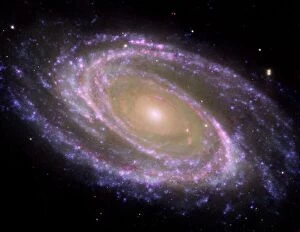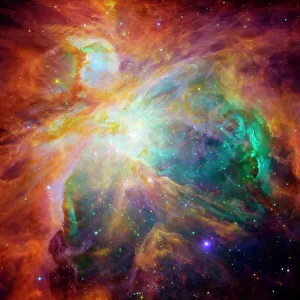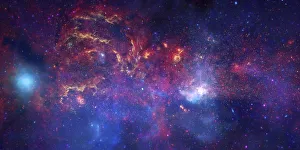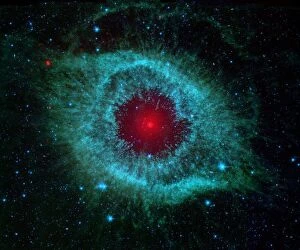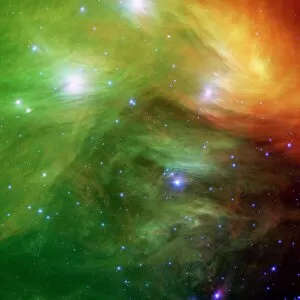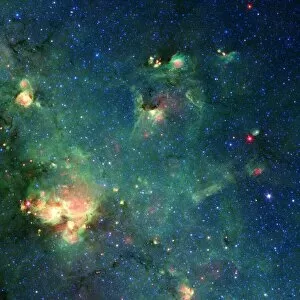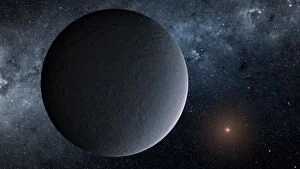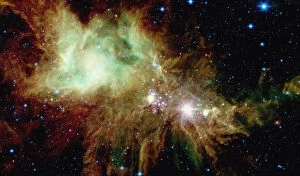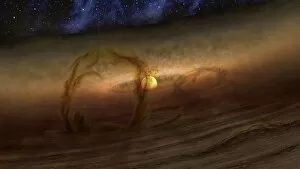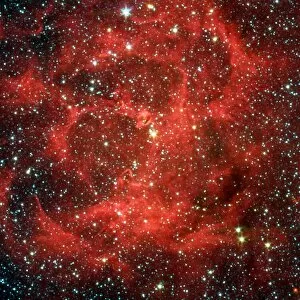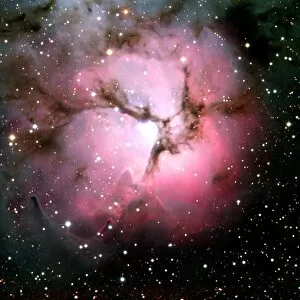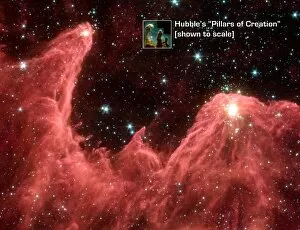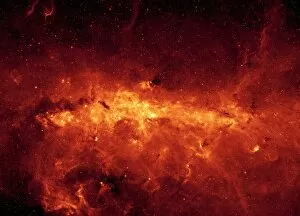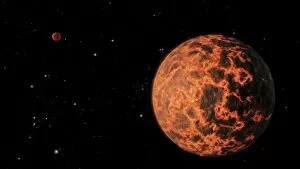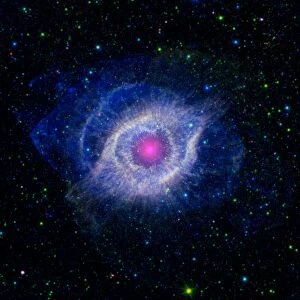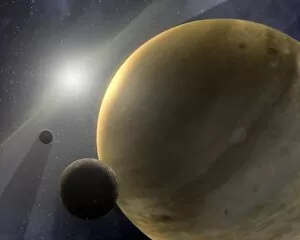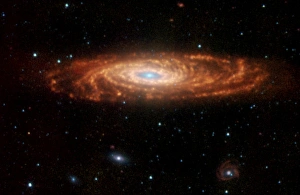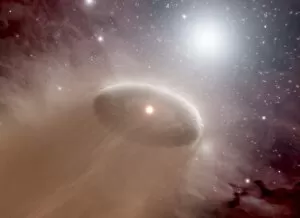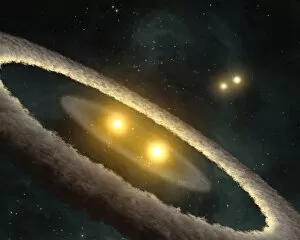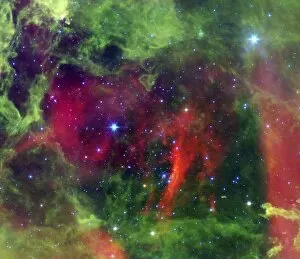Spitzer Collection
Spitzer Space Telescope is a NASA infrared space telescope launched in 2003, and is the fourth and final of the Great Observatories program
Choose a picture from our Spitzer Collection for your Wall Art and Photo Gifts
45 items
All Professionally Made to Order for Quick Shipping
-
Spitzer Collection
Spitzer Space Telescope is a NASA infrared space telescope launched in 2003, and is the fourth and final of the Great Observatories program, which includes Hubble, Chandra, and Compton Gamma Ray Observatory. Spitzer has been used to observe distant galaxies and stars, study exoplanets, and explore the formation of stars and planets. Its advanced infrared technology allows it to detect objects that are too faint or too far away for other telescopes to see. Spitzer has made many discoveries since its launch including finding evidence of organic molecules in interstellar clouds, discovering new star forming regions in our galaxy, and detecting a planet outside our solar system for the first time ever and has also provided us with detailed images of comets, asteroids, nebulae, supernovae remnants as well as protoplanetary disks around young stars. Spitzer continues to be an invaluable tool for astronomers today as they continue their exploration into deep space.
+
Our beautiful pictures are available as Framed Prints, Photos, Wall Art and Photo Gifts
The Spitzer collection from Media Storehouse is a stunning array of wall art and framed prints that capture the beauty of space exploration. Named after the Spitzer Space Telescope, which was launched by NASA in 2003 to study the universe in infrared light, our collection features breathtaking images of galaxies, nebulas, stars, and planets. Each print is carefully curated to showcase the intricate details and vibrant colors found in our vast cosmos. From close-up shots of Saturn's rings to panoramic views of distant star clusters, these prints are perfect for anyone who loves astronomy or simply wants to add a touch of cosmic wonder to their home or office decor. The Spitzer collection offers a range of sizes and framing options so you can choose the perfect piece for your space. Whether you're an avid stargazer or just appreciate beautiful photography, our collection is sure to inspire awe and wonder at the majesty of our universe.
+
What are Spitzer (Space Exploration Science) art prints?
Spitzer art prints are high-quality reproductions of stunning images captured by the Spitzer Space Telescope. These prints showcase the beauty and wonder of our universe, featuring breathtaking views of galaxies, nebulas, stars, and other celestial objects. The Spitzer Space Telescope is one of NASA's Great Observatories and has been instrumental in advancing our understanding of the cosmos since its launch in 2003. Each Spitzer art print is carefully crafted to capture the intricate details and vibrant colors present in these awe-inspiring space images. They make for a perfect addition to any home or office decor and serve as an excellent gift for astronomy enthusiasts or anyone who appreciates the wonders of space exploration. We offer a wide selection of Spitzer art prints that are available in various sizes and formats to suit your preferences. Whether you're looking for a small framed print or a large canvas wall hanging, there's something for everyone at Media Storehouse.
+
What Spitzer (Space Exploration Science) art prints can I buy from Media Storehouse?
We offer a wide range of Spitzer art prints that are available for purchase. These prints showcase the incredible beauty and wonder of our universe as captured by NASA's Spitzer Space Telescope. You can choose from a variety of stunning images, including galaxies, nebulae, stars, and more. Each print is produced using high-quality materials to ensure that it looks beautiful and lasts for years to come. Whether you're looking for a large canvas print to hang on your wall or a smaller framed print to display on your desk or bookshelf, we have something for everyone. These Spitzer art prints make great gifts for anyone who loves space exploration or astronomy. They are perfect for adding some color and excitement to any room in your home or office. So why not explore the wonders of our universe with these amazing Spitzer art prints from Media Storehouse?
+
How do I buy Spitzer (Space Exploration Science) art prints?
To purchase Spitzer art prints from Media Storehouse, you can browse our extensive collection of images online. Once you have found the print that you would like to purchase, simply add it to your cart and proceed to checkout. You will be prompted to enter your shipping and payment information before finalizing your order. We offer a variety of sizes for their prints, so be sure to select the size that best fits your needs. We also offer different framing options if you wish to have your print framed upon delivery. If you have any questions or concerns about purchasing Spitzer art prints from Media Storehouse, they provide customer support via email or phone. Their team is happy to assist with any inquiries regarding their products or services. Buying Spitzer art prints from Media Storehouse is a straightforward process that allows customers access to high-quality space exploration science imagery in just a few clicks.
+
How much do Spitzer (Space Exploration Science) art prints cost?
We offer a wide range of Spitzer art prints that vary in price depending on the size and type of print you choose. Our collection includes high-quality photographic prints, canvas prints, framed prints, and more. Each print is carefully crafted to showcase the stunning beauty and complexity of our universe as captured by NASA's Spitzer Space Telescope. Whether you're looking for a small print to display on your desk or a large statement piece for your living room wall, we have options to suit every budget and style preference. Our Spitzer art prints make great gifts for space enthusiasts or anyone who appreciates breathtaking photography. We pride ourselves on offering affordable prices without sacrificing quality. We believe everyone should have access to beautiful artwork that inspires awe and wonder at the mysteries of our universe.
+
How will my Spitzer (Space Exploration Science) art prints be delivered to me?
Your Spitzer Space Exploration Science art prints will be delivered to you via a trusted courier service. We take great care in ensuring that your order is packaged securely and arrives at your doorstep in pristine condition. Our team of experts use high-quality materials to protect your artwork during transit, including sturdy cardboard tubes and protective wrapping. Once your order has been dispatched, you will receive an email confirmation with tracking information so that you can monitor the progress of your delivery. If for any reason there are delays or issues with delivery, our customer service team is always available to assist you. We pride ourselves on providing exceptional customer service and delivering high-quality products that exceed expectations. Whether it's a gift for someone special or a piece of art for yourself, we want the experience of receiving your Spitzer Space Exploration Science art prints to be as seamless and enjoyable as possible.


